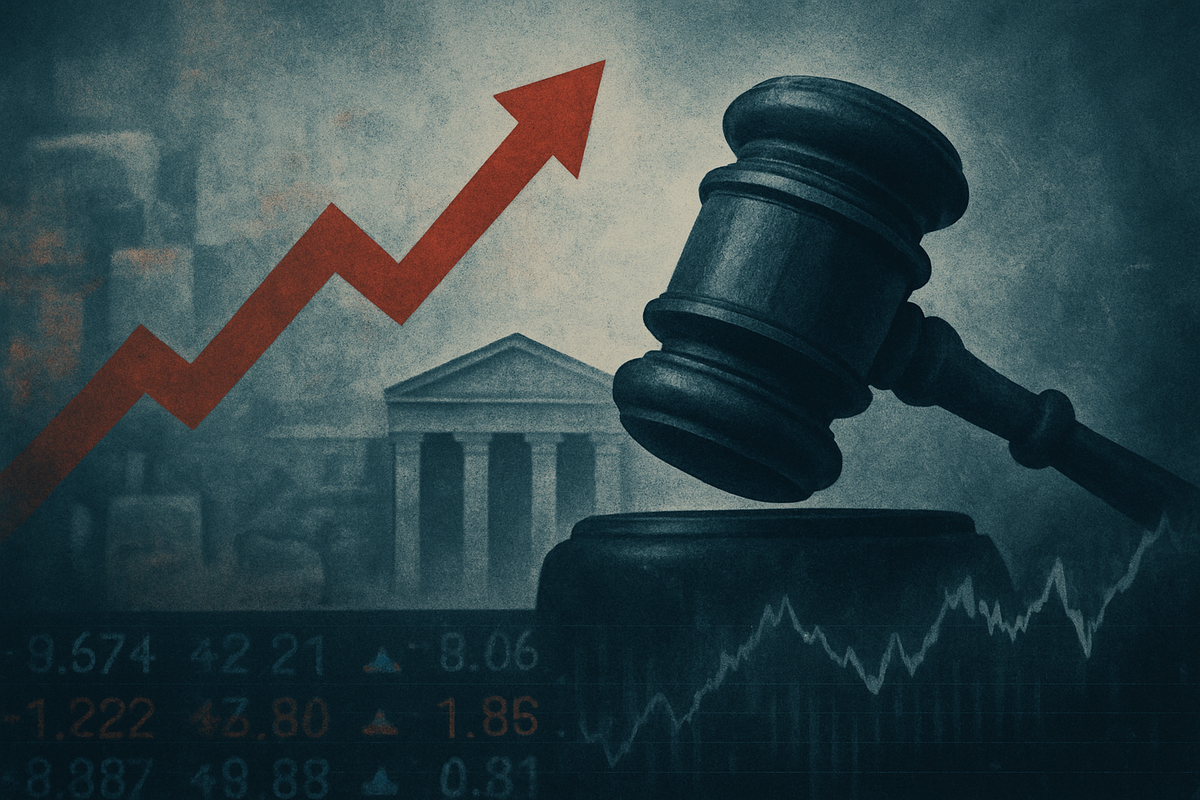
The United States economy finds itself at a critical juncture in late October 2025, grappling with stubbornly elevated inflation rates that continue to defy the Federal Reserve's long-term target, even as signs of a softening labor market emerge. The latest inflation data, particularly the Consumer Price Index (CPI) and the Personal Consumption Expenditures (PCE) price index, present a complex picture for policymakers. These figures are compelling the Federal Reserve to maintain its accommodative stance through continued interest rate reductions, despite the lingering price pressures, as it navigates a delicate balance between curbing inflation and supporting economic growth.
This ongoing monetary policy pivot by the Fed, marked by a series of anticipated rate cuts, signals a significant shift from the aggressive tightening cycle of previous years. The immediate implications are profound, suggesting a period of lower borrowing costs for consumers and businesses, but also highlighting the persistent challenges in fully taming inflation. The market is closely watching every pronouncement from the Federal Open Market Committee (FOMC), as its decisions will undoubtedly shape the trajectory of the US economy and global financial markets in the coming months.
Unpacking the Latest Inflation Data and the Fed's Response
The most recent data paints a clear, albeit challenging, economic landscape. For the 12 months ending September 2025, the annual CPI inflation rate registered 3.0%, a slight uptick from 2.9% in August. Core CPI, which excludes the volatile food and energy sectors, also stood at 3.0% annually in September, a minor deceleration from 3.1% in the preceding two months. Key drivers of the September CPI increase included a notable 4.1% rise in gasoline prices and a 1.5% increase in the overall energy index, alongside a 3.1% annual increase in food prices and a 3.6% rise in shelter costs.
The Federal Reserve's preferred inflation gauge, the PCE price index, indicated an annual headline inflation rate of 2.74% for August 2025, with core PCE inflation at 2.91%. Both figures remain comfortably above the Fed's long-term 2% target, underscoring the persistent inflationary pressures in the economy. This data arrives amidst a backdrop of a weakening labor market, with unemployment rising to 4.3% in August—the highest since October 2021—and job growth stalling, adding only 22,000 positions that month.
In response to this intricate economic scenario, the Federal Reserve is widely expected to cut interest rates by 0.25 percentage points at its upcoming FOMC meeting on October 28-29, 2025. This would bring the benchmark federal funds rate to a target range of 3.75% to 4.00%, following a similar 25-basis-point cut in September. This series of cuts is largely seen as a "risk management" strategy by the Fed to prevent a more significant slowdown in the labor market. Adding to the complexity, an ongoing government shutdown has created a "data blackout," forcing policymakers to make crucial decisions based on incomplete economic information, leading some economists to observe a "whiff of stagflation"—elevated inflation coupled with weak employment.
Corporate Winners and Losers in a Shifting Economic Climate
The Federal Reserve's continued pivot towards lower interest rates, driven by persistent inflation and a softer labor market, will undoubtedly create a divergence in fortunes across various sectors and public companies. Companies with significant debt loads or those reliant on consumer spending are likely to be among the primary beneficiaries, while others might face increased pressure.
Potential Winners:
- Real Estate and Construction: Lower interest rates typically translate to reduced mortgage costs, stimulating demand for housing. Homebuilders like D.R. Horton (NYSE: DHI) and Lennar Corporation (NYSE: LEN) could see increased sales and improved profitability. Similarly, real estate investment trusts (REITs) with substantial debt, such as Prologis (NYSE: PLG), might benefit from lower financing costs.
- High-Growth Technology Companies: These companies often rely on significant capital investment and are sensitive to the cost of borrowing. A lower interest rate environment makes it cheaper to fund expansion, research and development, and acquisitions. Tech giants like Microsoft (NASDAQ: MSFT), Apple (NASDAQ: AAPL), and emerging tech firms could see improved valuations and greater investment appetite.
- Consumer Discretionary: Reduced borrowing costs for consumers can free up disposable income, boosting spending on non-essential goods and services. Retailers like Amazon (NASDAQ: AMZN), Target (NYSE: TGT), and leisure companies could experience higher sales volumes.
- Companies with High Debt-to-Equity Ratios: Businesses that have accumulated substantial debt will see their interest expenses decrease, improving their bottom line. This could particularly benefit capital-intensive industries.
Potential Losers:
- Financial Institutions (Banks): While lower rates can stimulate loan demand, they often compress net interest margins (NIMs) for banks like JPMorgan Chase (NYSE: JPM) and Bank of America (NYSE: BAC). The difference between what banks earn on loans and what they pay on deposits shrinks, potentially impacting profitability.
- Companies with Strong Cash Positions: In a low-interest-rate environment, the returns on cash holdings diminish. Companies like Alphabet (NASDAQ: GOOGL) or Meta Platforms (NASDAQ: META), which often hold large amounts of cash, might see reduced investment income.
- Utilities and Dividend Stocks: These sectors are often seen as bond proxies, offering stable income. When bond yields fall due to lower interest rates, their relative attractiveness might decrease, as investors seek higher returns elsewhere.
- Companies with Significant Exposure to Inflationary Inputs: While the Fed is cutting rates, inflation remains elevated. Companies heavily reliant on commodities or imported goods, if they cannot pass on costs, could see profit margins squeezed. This could affect manufacturers or companies with complex supply chains.
The nuanced impact means that companies with agile financial management and strong pricing power will be better positioned to navigate this evolving economic landscape.
Broader Economic Implications and Historical Context
The Federal Reserve's current monetary policy trajectory, characterized by continued rate cuts amidst persistent inflation and a softening labor market, carries significant broader implications for the US economy and fits into a complex pattern of historical precedents. This delicate balancing act underscores the Fed's dual mandate: achieving maximum employment and stable prices.
The ongoing "risk management" approach to rate cuts reflects a proactive attempt to avoid a deeper economic downturn, particularly a recession triggered by an overly tight monetary policy. This strategy is reminiscent of periods where the Fed has eased policy in anticipation of, or in response to, economic weakness, rather than waiting for full-blown crises. For instance, in the late 1990s, the Fed cut rates preemptively during the Asian financial crisis to insulate the US economy. More recently, the swift rate cuts during the COVID-19 pandemic aimed to prevent a catastrophic collapse. However, the current scenario is distinct due to the stubbornly high inflation, which was less of a concern in those earlier easing cycles.
This situation also highlights a broader industry trend of central banks globally grappling with the aftermath of unprecedented monetary stimulus and supply chain disruptions. Many developed economies are facing similar challenges of elevated inflation and potential slowdowns. The US Fed's actions will have ripple effects on international markets, influencing currency exchange rates, global capital flows, and the monetary policy decisions of other central banks. A weaker dollar, a potential outcome of lower US interest rates, could make US exports more competitive but might also exacerbate imported inflation.
Regulatory and policy implications are also significant. The "data blackout" caused by the government shutdown adds an extra layer of uncertainty, potentially leading to policy decisions based on incomplete information. This situation could reignite debates about the importance of robust, timely economic data for effective policymaking and the need for fiscal stability to avoid such disruptions. Furthermore, if inflation remains sticky, it could prompt calls for more targeted fiscal policies or structural reforms to address specific supply-side bottlenecks rather than relying solely on monetary tools. The "whiff of stagflation" detected by some economists is a particularly concerning historical parallel, recalling the 1970s, a period of high inflation and stagnant economic growth, which required drastic measures to resolve. The Fed is keen to avoid a repeat of that protracted struggle.
The Path Ahead: Navigating Uncertainty
Looking ahead, the US economy and financial markets face a period of significant uncertainty, shaped by the Federal Reserve's ongoing monetary policy adjustments and the persistent tug-of-war between inflation and growth. Short-term, the market anticipates further rate cuts, with a high probability (around 94-95%) of another 0.25% reduction in December 2025, potentially culminating in a cumulative 0.75% reduction by year-end. J.P. Morgan Global Research even projects two more cuts in 2025 (after September's) and one in 2026. This easing cycle aims to provide liquidity and stimulate economic activity, particularly in sectors sensitive to interest rates.
However, the long-term possibilities are more complex. While lower rates could avert a severe recession, the continued presence of above-target inflation poses a significant challenge. If inflation proves more entrenched than anticipated, the Fed might find itself in a difficult position, forced to choose between aggressively fighting inflation, potentially at the cost of economic growth, or tolerating higher inflation to support employment. This could lead to a prolonged period of modest growth and elevated prices, a scenario that requires careful strategic pivots from businesses and investors alike.
For businesses, this environment demands adaptability. Companies will need to focus on enhancing operational efficiencies, managing input costs, and maintaining pricing power. Strategic adaptations might include diversifying supply chains to mitigate inflationary pressures, investing in automation to counter labor market tightness, and carefully managing debt to leverage lower interest rates without overextending. Market opportunities may emerge in sectors that benefit from lower borrowing costs, such as housing and technology, or in companies that can innovate to provide value in an inflationary environment. Conversely, challenges will persist for businesses with high fixed costs, limited pricing power, or those heavily reliant on discretionary consumer spending if economic sentiment deteriorates.
Potential scenarios range from a "soft landing," where inflation gradually recedes without a significant recession, to a more challenging "stagflationary" outcome if inflation remains high while economic growth falters. Investors will need to closely monitor inflation prints, labor market data, and, crucially, the Federal Reserve's communications, especially Chairman Powell's press conferences, for signals regarding the Fed's assessment of the economy and its future policy direction. The ongoing "data blackout" due to the government shutdown further complicates this outlook, increasing the risk of misjudging an economy exhibiting mixed signals.
A Critical Juncture for Markets and the Economy
The current state of US inflation data and the Federal Reserve's response marks a critical juncture for both financial markets and the broader economy. The persistent inflationary pressures, coupled with a discernible softening in the labor market, have compelled the Fed to continue its easing cycle, signaling a strategic shift to mitigate economic downside risks. The expected interest rate cuts are a clear indication of the central bank's commitment to supporting employment, even as it grapples with inflation that remains above its target.
The key takeaway is the delicate balance the Fed is attempting to strike. It is easing monetary policy to prevent a deeper economic slowdown, but it cannot ignore the inflationary environment. This creates a market characterized by both opportunity and caution. Companies with strong balance sheets, adaptable business models, and those poised to benefit from lower borrowing costs are likely to navigate this period more effectively. Conversely, those with high exposure to fluctuating commodity prices or intense competition may face headwinds.
Moving forward, investors should remain highly attuned to incoming economic data, particularly the monthly CPI and PCE reports, as well as the employment situation. The Federal Reserve's communications, including any forward guidance from Chairman Powell, will be paramount in deciphering the likely trajectory of monetary policy. The ongoing "data blackout" adds an element of uncertainty, emphasizing the need for investors to consider a range of potential scenarios. The lasting impact of this period will depend on whether the Fed can successfully engineer a "soft landing," bringing inflation down without triggering a significant recession, or if the economy veers into a more protracted period of elevated prices and subdued growth. The coming months will be crucial in determining the ultimate outcome of this complex economic dance.
This content is intended for informational purposes only and is not financial advice





